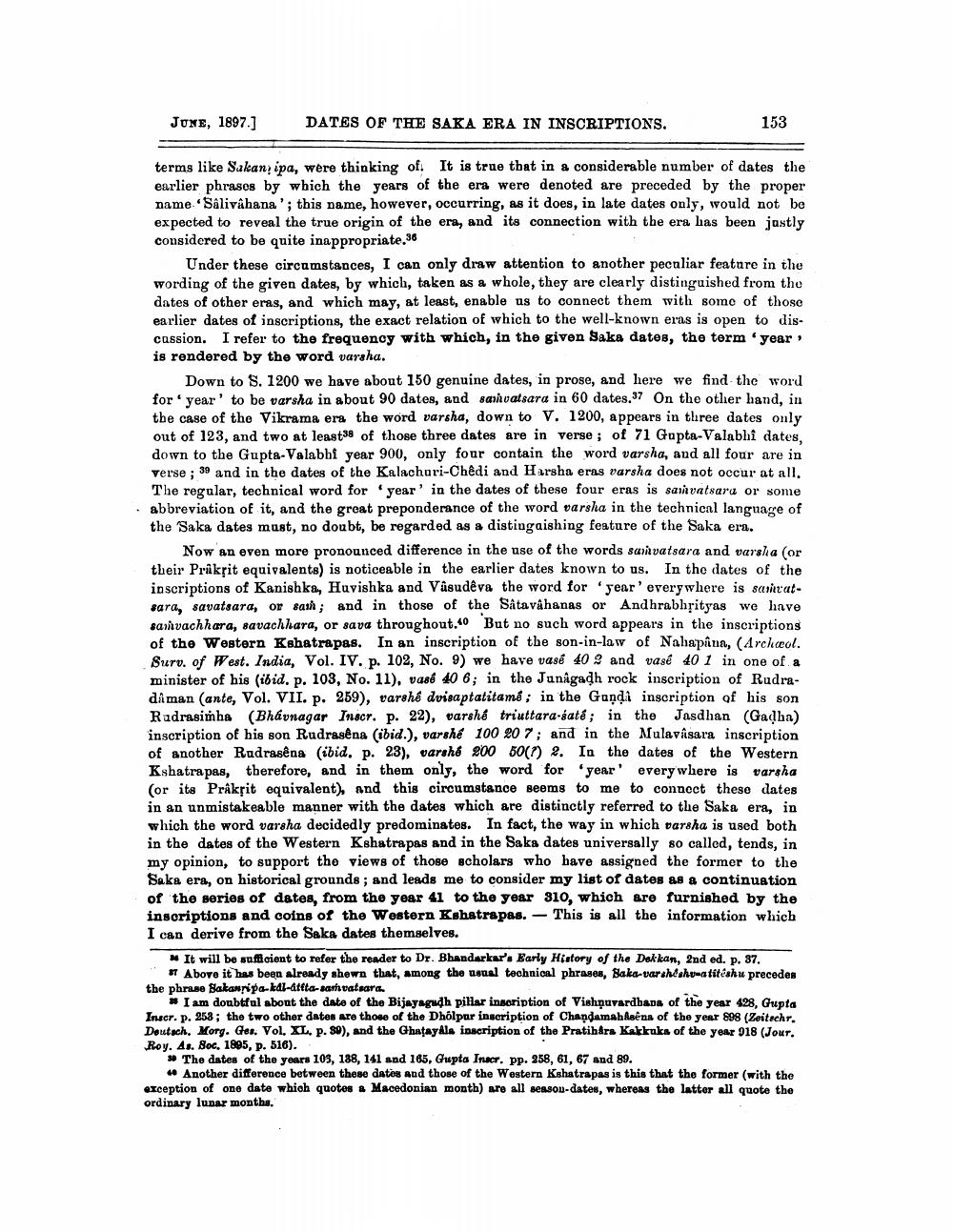________________
JUNE, 1897.]
DATES OF THE SAKA ERA IN INSCRIPTIONS.
153
terms like Sakan, ipa, were thinking of. It is true that in a considerable number of dates the earlier phrases by which the years of the era were denoted are preceded by the proper name Salivahana'; this name, however, occurring, as it does, in late dates only, would not be expected to reveal the true origin of the era, and its connection with the era has been jastly considered to be quite inappropriate.
Under these circumstances, I can only draw attention to another peculiar feature in the wording of the given dates, by which, taken as a whole, they are clearly distinguished from the dates of other eras, and which may, at least, enable us to connect them with some of those earlier dates of inscriptions, the exact relation of which to the well-known eras is open to discussion. I refer to the frequency with which, in the given Saka dates, the term 'year is rendered by the word varsha.
Down to S. 1200 we have about 150 genuine dates, in prose, and here we find the word for year' to be varsha in about 90 dates, and samvatsara in 60 dates.37 On the other hand, in the case of the Vikrama era the word varsha, down to V. 1200, appears in tlıree dates only out of 123, and two at least 38 of those three dates are in verse; of 71 Gupta-Valabhi dates, down to the Gupta-Valabhi year 900, only four contain the word varsha, and all four are in verse ; 39 and in the dates of the Kalachuri-Chêdi and Harsha eras varsha does not occur at all. The regalar, technical word for year' in the dates of these four eras is samvatsara or some abbreviation of it, and the great preponderance of the word varsha in the technical language of the "Saka dates must, no doubt, be regarded as a distingaishing feature of the Saka era.
Now an even more pronounced difference in the use of the words sanvatsara and varslia (or their Prikrit equivalents) is noticeable in the earlier dates known to us. In the dates of the inscriptions of Kanishka, Huvishka and Väsudêva the word for year' everywhere is saritatsara, savatsara, or sash; and in those of the Satavahanas or Andhrabhsityas we have sarnvachhara, savachhara, or sava throughout.co But no such word appears in the inscriptions of the Western Kshatrapas. In an inscription of the son-in-law of Nahapana, (Archwol. Surv. of West. India, Vol. IV. p. 102, No. 9) we have vasé 40 and vasé 40 1 in one of a minister of his (ibid. p. 103, No. 11), vasé 40 6; in the Junagadh rock inscription of Rudradaman (ante, Vol. VII. p. 259), varshé dvisaptatitamé ; in the Gandi inscription of his son Radrasimha (Bhavnagar Inscr. p. 22), varshe triuttara-saté; in the Jasdhan (Gadba) inscription of his son Rudrasena (ibid.), varshé 100 20 7; and in the Nulavasara inscription of another Radrasena (ibid. p. 23), varshé 200 50(1) 2. In the dates of the Western Kshatrapas, therefore, and in them only, the word for year' everywhere is varsha (or its Prâksit equivalent), and this circumstance seems to me to connect these dates in an unmistakeable manner with the dates which are distinctly referred to the Saka era, in which the word varsha decidedly predominates. In fact, the way in which Darsha is used both in the dates of the Western Kshatrapas and in the Saka dates universally so called, tends, in my opinion, to support the views of those scholars who have assigned the former to the Saka era, on historical grounds; and leads me to consider my list of dates as a continuation of the series of dates, from the year 41 to the year 810, which are furnished by the inscriptions and coins of the Western Kshatrapas. - This is all the information which I can derive from the Saka dates themselves. " It will be sufficient to refer the reader to Dr. Bhandarkar's Early History of the Dakkan, 2nd ed. p. 37.
Above it has been already shewn that, among the usual technical phrases, Saka-varshishv-atítéshu precedes the phrase Sakanipa-kal-attta-samvatsara
* I am doubtful about the date of the Bijayagadh pilar insoription of Vishnuvardhana of the year 428, Gupta Inscr. p. 253; the two other dates are those of the Dholpur inscription of Chandamah Asena of the year 898 (Zeitschr. Deutsch, Morg. Ges. Vol. XL. p. 89), and the Ghataykla inscription of the Pratihdra Kakkaks of the year 918 (Jour. Roy. As. Soc. 1895, p. 516). * The dates of the years 103, 188, 141 and 185, Gupta Inact. Pp. 258, 61, 67 and 89.
Another difference between these dates and those of the Western Kshatrapas is this that the former (with the exception of one date which quotes a Macedonian month) are all sessou-dates, whereas the latter all quote the ordinary lunar months.




